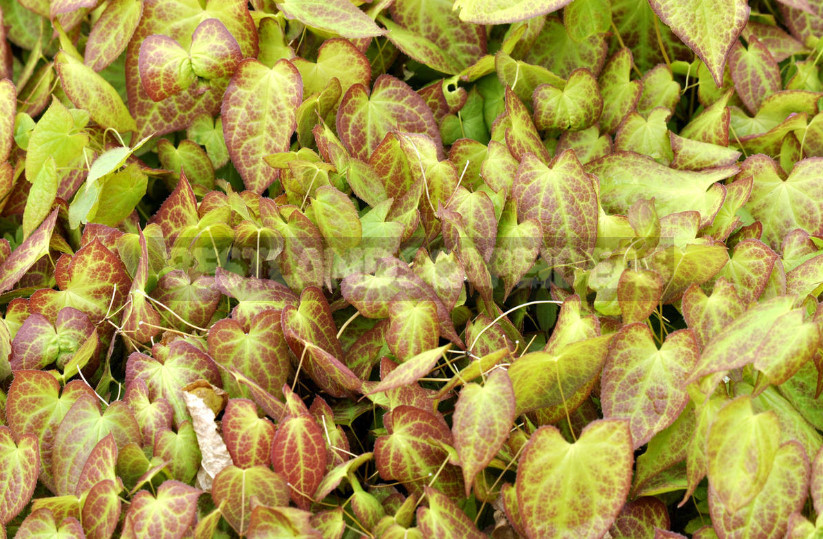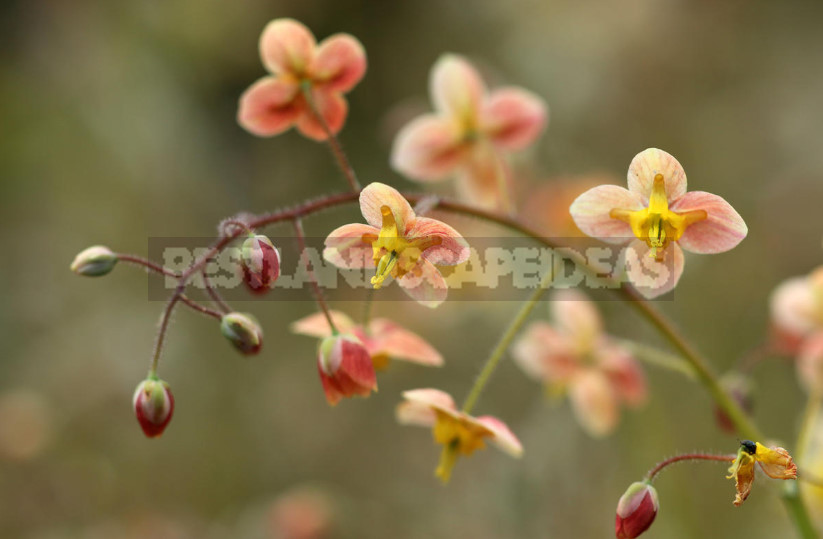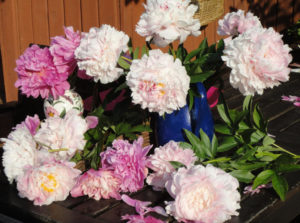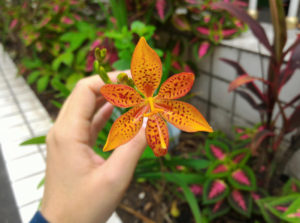
At first glance, it would seem that what can deceive the most experienced gardener in Epimedium? And they have a few green leaves and a few small flowers. And this is in the spring, when lush tulips are already blazing in the open, and shady corners are full of placers of colorful primroses. But there is something fascinating about these plants that attracts collectors and ordinary gardeners.
Plant description
The genus Epimedium belongs to the family Berberidaceae. It already has more than 50 species, which is interesting, it is distributed only in the Eastern Hemisphere and continues to be replenished with new finds from China. Epimedium is a typical forest plant. In nature, they form dense thickets on humus-rich, slightly moist soil under the canopy of foothill forests and bloom, while the young foliage completely hides the sun. They are not used to the open sun, especially in the summer, in the heat. Even spring, except in the morning and evening, can burn their leaves. Therefore, when planting, it is desirable to create an epimedium, the condition of which is similar to the natural one, in order to place them better in the shade or partial shade from tall trees and shrubs. They also grow with pleasure under the protection of large stones, on the northern and eastern slopes.
The rhizomes of the Epimedium are branched, but they are located quite superficially, and the roots go into the ground shallowly, so if there is a lack of rain, the epimedium needs watering. However, waterlogging, especially in the cold season, they also do not tolerate. The acidity of the soil is usually recommended closer to neutral, because in nature many species grow on limestone. However, in my experience, they are not too demanding on this parameter, only strongly acidic soils should be avoided. Like most forest plants, Epimedium mulches the ground well with loose organic matter that does not acidify the soil. It is similar to the forest autumn, which is formed annually in nature.
Pests and diseases in the middle zone and Epimedium are not affected.
Reproduction Of Epimedium
Propagate them with segments of rhizomes 7-10 cm (2.7-3.9 in) long with buds and roots in September, but you can also in early spring. In contrast to the natural, superficial and almost horizontal arrangement, it is desirable to plant such cuttings in a planting pit obliquely, cut deep, and the largest buds should only slightly protrude above the soil level. Shorter cuttings or cuttings with a small number of roots, I sometimes plant even vertically.
Seed propagation requires a complex two-stage stratification: first at room temperature (about + 20 ° C/68°F), then for another month at +5 °C (41°F). Young plants obtained in this way do not bloom soon. What can I say, even a small epimedium can not bloom until the young bush does not gain a green mass.
Epimediums are not only decorative, they have medicinal properties, they are used to improve blood supply, reduce pressure and increase immunity, although most often they are used as a tonic and potency — enhancing agent-the glycoside incarin contained in Epimedium is part of Viagra.
Types Of Epimedium
Epimedium pinnatum ssp. colhicum comes from the dry forests of the foothills of the Caucasus and Turkey. It forms dense thickets with multilevel foliage. In our country, it overwintered without shelter, even when it reached-40 °C (-40°F), and bloomed, although according to the recommendations of preventive shelter, the leaf is desirable.
From Epimedium pinnatum ssp. colhicum, the foliage is evergreen, more precisely, winter-green. The old leathery leaves are partially preserved until spring. Young-like many epimedias, light green with a purple blush and even brighter edging. Against their background, long brushes of yellow flowers with a “spout” and purple sepals look especially elegant. Glossy dark green foliage forms a continuous cover up to 30 cm (11.8 in) high. True, in the colder parts, last year’s leaves turn red during the winter; but then they can be cut off without harm to the plant. By autumn Epimedium pinnatum ssp. colhicum and some other leaves may turn reddish again.
E. x rubrum is a natural hybrid of E. grandiflorum and E. alpinum. It forms loose lumps up to 35-40 cm (13.7-15.7 in) high. Blooms in May. In the north-west, winter hardy without shelter. Prefers shade or partial shade.
The young foliage of E. x rubrum is red-purple, almost without greenery, like a fiery waterfall. The leaves become especially bright towards the end of flowering. In June, the leaves begin to gradually lose their spectacular color, but then it’s the turn of other plants to show their beauty.
During flowering, the red ones with a white center and flowers flash like embers in the sun. For the delicate flowers that resemble moths fluttering among the delicate foliage, in Europe epimedium is called “flower elves”. Flowers with “horns” or elegant long spurs are not uncommon among epimediums, but the shape, color and size vary greatly from species to species.
In Europe, the most common E. grandiflorum is 20-30 cm (7.9-11.8 in) tall with lilac flowers. It is native to Manchuria and Japan. On its basis, many garden hybrids are derived. The ‘Lilacinum’ and compact varieties ‘Lilafe’ have purple flowers,‘Rose Queen’ have pink flowers, and the powerful ‘White Queen’ have white flowers. However, not all varieties winter well and bloom in the northern regions, flower buds can be damaged by periodic frosts. In the middle lane, it’s easier.
E. grandiflorum ‘Nanum’, which means “small” (height only 8-15 cm/3.1-5.9 in, up to 20 cm/7.9 in), pure white miniature flowers that shine like pearls against a dense bush with delicate foliage. Unlike others, this variety does not form a branching rhizome, the base of the bush is more like a tuber of closely intertwined shortened shoots with fibrous roots. It is particularly demanding to maintain a constant but moderate soil moisture content.
In addition to the above, the following types of epimedium are quite hardy under the snow:
- E. alpinum height 15-25 cm (5.9-9.8 in), with small light yellow flowers.
- E. koreanum it grows up to 15-20 cm (5.9-7.9 in) in height. Light green leaves and large (up to 2.5 cm/1 in) cream, light yellow, pink or purple flowers with a lighter center with spurs bloom in May. They prefer shade. Unpretentious and frost-resistant, but grows slowly.

- E. pauciflorum through long creeping rhizomes, it forms loose thickets with beautiful leathery leaves and small panicles of delicate pink flowers. It drowns and displaces its neighbors.
- E. x versicolor it is a hybrid of E. grandiflorum and Epimedium pinnatum ssp. colhicum. The shrub has a height of 30-45 cm (11.8-17.7 in), the leaves are overwintered, young bright-colored, the flowers are creamy-yellow.
- A common variety in gardens is E. x versicolor sulphur yellow E. x versicolor var. the flowers of sulphureum are more saturated in color, up to 1.5 cm (0.6 in) in diameter. This variety is drought-resistant, as is its progenitor-Epimedium pinnatum ssp. colhicum.
In the gardens you can also find: E. x warleyense with large copper-orange flowers, known for their variety ‘Orangekönigin’ / ‘Orange Königin’ ; quite drought-resistant E. niveaum, E. pubigerum from the Western Caucasus and Asia Minor with yellowish flowers; light-loving E. x youngianum with small white or lilac flowers and some other species.

In case of danger of snowless frosts for E. grandiflorum and its varieties, especially European novelties, E. pubigerum and E. x youngianum, it is desirable to cover for the winter with a dry leaf, even in the middle zone.
Promising species includes: E. brachyrrhizum, E. brevicornu, E. franchetii, E. davidii, E. stellulatum и E. x omeiense.
Attention! E. acuminatum – a spectacular large-flowered novelty, but it is not hardy enough.
The most suitable company for hot springs in a shady garden under a canopy of deciduous trees and tall shrubs can be Heuchera and Pulmonaria, compact varieties of Ligularia and spring-flowering small-bulb, Hosta, Primula and Polypodiopsida. A little finesse would be nice in any garden.




Leave a Reply